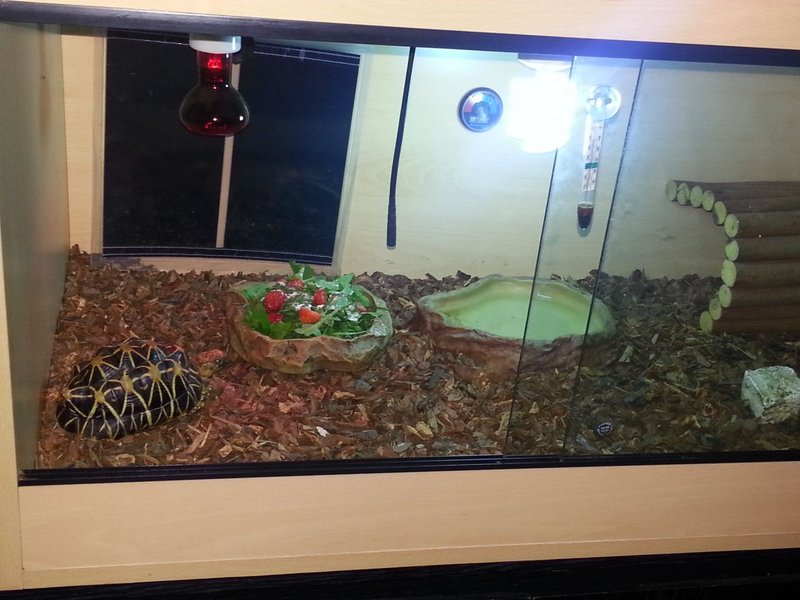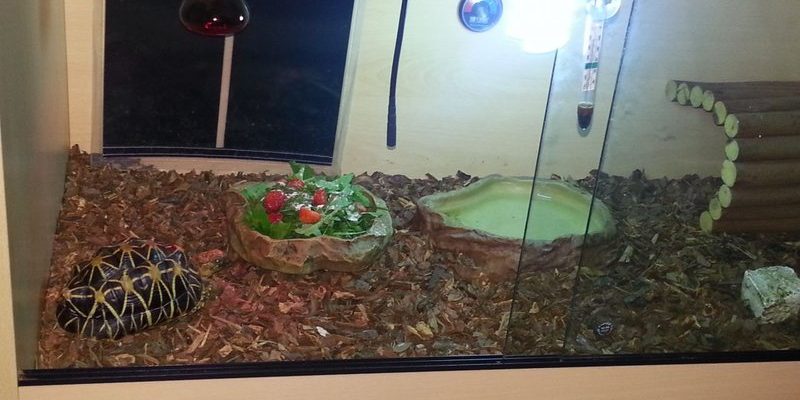
When thinking about housing the Indian Star Tortoise, you’ll want to consider a few key elements, much like setting up a perfect living room. From the right space to temperature control, each detail counts. This guide will break it all down for you, making it easy to create a suitable home sweet home for your shelled companion.
Understanding the Indian Star Tortoise’s Needs
Before you start assembling an enclosure, it’s essential to understand what makes the Indian Star Tortoise tick. These fascinating creatures thrive in dry, warm climates and require specific elements to feel at home. Their natural habitat is the dry forests of India and Sri Lanka, where they enjoy open spaces with plenty of sunlight.
You might be wondering what that means for their enclosure. Here’s the thing: you need to replicate their natural environment as closely as possible. This involves incorporating elements like a basking area, hiding spots, and proper substrate. By mimicking their habitat, you’ll help your tortoise feel secure and comfortable, promoting overall well-being.
Choosing the Right Enclosure Size
When it comes to the size of your tortoise’s enclosure, bigger really is better. A larger space allows your tortoise to roam, explore, and get the exercise they need. Ideally, the enclosure should be at least 4 feet long for a single Indian Star Tortoise, but even larger is preferable if you have the space.
An enclosure that’s too small can lead to stress and health issues. It’s a bit like living in a tiny apartment with no room to move. So, consider whether you want a wooden outdoor tortoise table, a greenhouse, or even a spacious indoor cage. Just remember, the more room they have, the happier they will be!
Best Materials for Enclosure Construction
The materials you choose for your tortoise’s enclosure can make a significant difference in their comfort and safety. Many tortoise owners opt for wooden enclosures since they are sturdy and can be customized to fit any space. Just make sure to use untreated wood to avoid any harmful chemicals leaching into their environment.
You could also consider fiberglass or plastic enclosures, which are easier to clean and maintain. If you’re building an outdoor enclosure, ensure that it has a secure top to protect your tortoise from potential predators. Remember, the goal is to create a safe, inviting space that allows your tortoise to thrive.
Creating the Perfect Substrate
Substrate is an often-overlooked aspect of tortoise housing, but it plays a crucial role in their health. You want to provide a substrate that mimics their natural ground. A mix of coconut coir, topsoil, and sand can work wonders. This combination allows for easy digging and helps maintain humidity levels, which is vital for your tortoise’s well-being.
Here’s a tip: keep the substrate depth at around 2 to 4 inches. This depth gives your tortoise enough space to burrow and feel secure. Just remember to change the substrate regularly to prevent any buildup of waste or mold. A clean space is a happy space, after all!
Heating and Lighting in the Enclosure
Heating and lighting are two of the most critical factors when it comes to housing an Indian Star Tortoise. Having a basking area with a heat lamp is essential, as these tortoises need warmth to digest their food and maintain energy levels. A temperature gradient is ideal, with a basking spot around 90°F and cooler areas around 75°F.
You’ll also want to provide UVB lighting to ensure your tortoise gets adequate exposure to essential UV radiation. This helps in calcium absorption, which is crucial for shell health. A 10-12 hour light cycle is perfect, mimicking natural daylight. So, don’t forget to invest in good quality heating and lighting equipment!
Incorporating Hiding Spots and Enrichment
Your tortoise needs more than just space; they also require hiding spots and enrichment activities to keep them stimulated. Think of it as adding furniture and decorations to your home. Hiding spots offer your tortoise a chance to retreat when they feel stressed or want some privacy.
You can use rocks, logs, or even commercial hideouts designed for reptiles. Arranging these items in a way that encourages exploration and climbing can make your enclosure more dynamic. You might also consider adding plants that are safe for tortoises—for example, dandelions or clover.
Water and Feeding Stations
Providing fresh water and a proper feeding station is another crucial aspect of your tortoise’s home. Make sure to include a shallow dish for water, as tortoises often drink by soaking. Change the water daily to keep it clean and fresh.
For meals, you can set up a designated area with healthy greens and veggies. Tortoises love a varied diet, so consider offering a mix of romaine lettuce, kale, and even commercial tortoise pellets. Just remember to remove uneaten food after a few hours to prevent spoilage and keep the enclosure hygienic.
Common Issues to Watch For
Even with the best setup, you might encounter some common issues. One concern is temperature fluctuations, which can affect your tortoise’s health. Regularly monitor the basking and ambient temperatures to ensure they stay within the ideal range.
Another common problem is dehydration, particularly if you live in a dry climate. Ensure your tortoise has constant access to water and mist the enclosure occasionally to maintain humidity. If you notice your tortoise being lethargic or not eating, it may be time for a check-up at the vet.
Final Thoughts on Housing Your Indian Star Tortoise
Properly housing your Indian Star Tortoise involves more than just creating an enclosure; it’s about crafting a thriving environment that mirrors their natural habitat. With the right size, materials, heating, and enrichment, you can provide a snug home where they can live happily. Take your time to set up a comfortable space that meets their needs, and you’ll find that your tortoise thrives in their new home. Remember, it’s about making sure they feel safe and cared for, which, after all, is what we all want at the end of the day!

